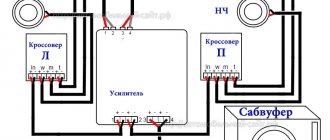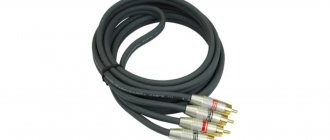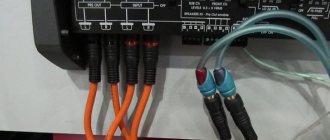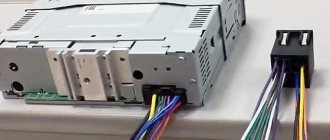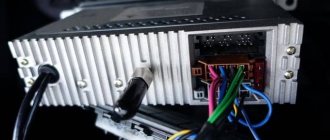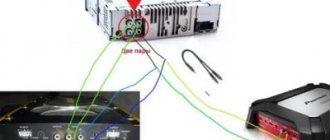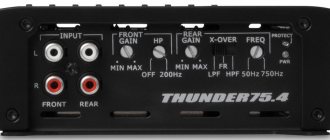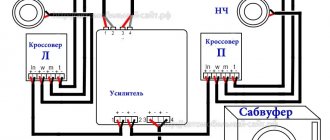A modern car has a set of standard options that provide the driver and his passengers with comfort and safety while driving. However, the standard multimedia system (radio) installed on the car often does not satisfy car owners in terms of sound quality.
This problem is usually solved by installing a non-standard power amplifier, especially if the speakers themselves in the car are replaced with more powerful and high-quality ones. Also, another radio cassette can often be installed.
At the same time, it is important to know how to connect the amplifier in the car correctly in order to get full functionality and good results. Let's look at how to connect the amplifier to the radio yourself.
Types and principle of operation
Before you get down to business, you should understand the principle of operation of the amplifier. Unlike stationary devices that operate on a 220-volt network, a device for a car is connected to the on-board network. The voltage here reaches only 12 volts. So the job of the amplifier is to take the weak signal and convert it into one that is suitable for driving the speakers. An important detail is that the received and converted signal differ not in wavelength, but only in its amplitude.
The internal structure of the amplifier consists of 3 elements:
- input circuit;
- power unit;
- output stage.
Input circuit. The amplifying device must be able to process signals of different levels. This is explained by the fact that the radio signals at the linear level can have different voltages. High level signals go directly to the load; if the level is low, the signal needs to pass through an amplifier.
In this case, it is important to take into account the correspondence of the signal level supplied from the head unit and the sensitivity of the input node.
Power unit. In operating condition, this unit converts low battery voltage into a higher voltage. For this purpose, the power supply is equipped with a transformer. An important feature of the sound signal is its variability, and therefore the functioning of the speakers requires 2 voltages at once: + and -. To achieve such conditions, voltages of different polarities are removed from the transformer. Their combination is used to obtain an alternating signal.
Output stage. This working unit includes powerful transistors, thanks to which increased voltage is supplied. This becomes possible due to the conversion of incoming signals
Manufacturers offer dozens of amplifier models with varying technical characteristics. According to the method of signal amplification, devices are divided into 2 categories:
- analog;
- digital.
Another classification is based on the quantitative difference between channels.
- Single channel. Such devices are designed for a nominal load of up to 2 ohms and are equipped with a volume control. More often, single-channel amplification devices are used to connect subwoofers.
- Two-channel. You can connect such a device to 2 dynamic heads, the power of which is higher than that of a single-channel amplifier for a car radio. An alternative option is to connect 1 powerful speaker.
- Three-channel. Devices with such characteristics are relatively rare.
- Four-channel. These are the most convenient devices that allow you to combine elements of an audio system. You can connect 4 speakers to such a device or use it as a two-channel device with a subwoofer connection.
- Five-channel. Such a device can be selected for a subwoofer and speakers.
- Six-channel. It is rarely used, since when it is used the battery is quickly discharged.
How to install
Before you begin installing the amplifier in the car, you should consider the location of all components of the audio system. Some car enthusiasts do not pay enough attention to these issues and install the amplifier and speakers in any place they like. As a result of this approach, difficulties arise during the work process, and the sound quality is not of good quality.
So, when installing an amplifier under the seat, you need to calculate the amount of cable required to lay from the radio to the amplifier and from the amplifying device to the speakers. In addition to the cable, you will need sets of adapters (in the absence of tulips) and other consumables.
In addition, depending on the location of the devices, you can more accurately calculate the power and quality of the sound produced. Settings can help with this.
Choosing the right place
Before starting work, you must select a location and prepare a sufficient amount of cable. According to rough estimates, during the installation of equipment in the luggage compartment, about 5 m of cable will be required to connect the multimedia system and 3 m for each speaker. More exact dimensions depend on the make of the car. In this case, the cable should be taken with a small margin, since the wires need to be laid under the interior trim.
When choosing where the subwoofer, speakers and amplifier will be located, you need to consider several recommendations.
- Sufficient air circulation. This requirement is explained by the fact that the amplifier gets very hot.
- Position. The device should be mounted in the correct position, preventing it from being turned on its side or from top to bottom.
- Do not cover the device with a rug or other things.
Experienced craftsmen suggest considering several suitable options for placing an amplifier under speakers.
- The central or front part of the cabin. This arrangement will save on cable costs and achieve good communication with the radio.
- Under the seat (you can use the passenger or driver's seat for this). This option will provide free, quick access if repair or replacement of the amplifier is required.
- On the back shelf. This connection diagram is suitable for cars with a coupe or sedan body.
- In the luggage compartment. This option is worth considering if you plan to connect 2 amplifiers.
Wires for installation
Wires for connecting the amplifier must be selected taking into account the power of the device. In addition, about 30% is added to this indicator, which is lost due to low efficiency.
For example, you can consider the characteristics of 2 two-channel amplifiers to which you need to select wires. The total power of these devices reaches 200 W, however, taking into account the maximum volume, they require a power of 260 W.
To determine which wires are needed for such equipment, use the Ohm's law formula: I=P/U. Here I stands for current, P stands for power, and U stands for voltage level.
The car battery has a voltage of 12V, so as a result of the calculation it turns out that the current is 21.6 A.
Fuse
The proximity of the power cable to the car body requires the installation of a fuse. If a short circuit occurs, this device will help prevent fire. It is recommended to install the fuse close to the battery, since the amplifier already has the necessary protective elements. The optimal fuse rating is 50 A. Devices with a larger value should not be selected.
When choosing a fuse, keep in mind that there are several types of such devices. In cars, only 2 types are most often used.
- AGU. These fuses consist of a glass cylinder with an exposed metal tip. Inside it there is an insert made of fusible material. This option is low cost, but it quickly breaks down as a result of frequent vibrations.
- ANL. Such a device is made from a solid metal plate and is fixed with bolts to the clamp.
When purchasing a fuse, it is important to consider the compatibility of its rating with the rating of the wiring. If the fuse characteristics are high, the wire will ignite during a short circuit. If the rating of this device is small, it may fail when peak loads occur.
If a car enthusiast installs powerful audio equipment, it makes sense to purchase a storage device. Some people don’t know why such a device is needed or whether it is needed. The device operates like a capacitor (it accumulates energy and then slowly releases it). As a result of this equipment, subsidence does not occur even when powerful acoustics are used.
Interconnect cable
The signal is supplied from the radio to the amplifying device via an interconnect cable. This part is extremely important, so it is not recommended to skimp on it. The quality of the received signal depends on the characteristics of the interconnect cable. You need to select this part taking into account the following features:
- a fairly thick central core (the cable should not be thin);
- continuous shielding;
- high quality durable insulation.
How to connect with your own hands
Those who do not know how to connect an amplifier to a car radio should first familiarize themselves with the tips and recommendations of experienced professionals. Another difficulty lies in the fact that there are several options for connecting the amplifier to the radio. This depends on the type of amplifier chosen, additional equipment, and mounting location.
The process has several nuances, taking into account which such situations can be identified.
- Connection in bridge mode.
- Carrying out installation if there are no linear outputs on the head unit. This situation often becomes a big problem for beginners when connecting an amplifier to a standard radio.
- The difference is in the connection diagram of the amplifier with speakers or with an additional subwoofer (passive or active).
- Availability of additional devices (remote microphone, headset).
- The need to connect an amplifier at home through a power supply.
- The presence of 2 amplifiers (how to connect amplifiers to the standard radio in this case).
The simplest connection of the amplifier is carried out according to the standard scheme. In this case, the amplifying device is connected directly to the battery.
Before connecting the car amplifier, the negative charge is connected to the car body (for the purpose of grounding). The positive charge must be connected to the battery terminal with the “+” sign.
After this diagram for connecting a car amplifier with a power source has been completed, it needs to be connected to other acoustic devices. During the work, you need to know which wire goes to the amplifier sockets.
A wire with red insulation on “+” is intended for connecting voltage.
The wire painted black at “-” is attached to the GND connector.
The signal cable coming from the radio is connected to the Remote socket.
In powerful audio systems, a capacitor is installed before connecting the amplifier in the car.
Step-by-step connection process
The entire workflow can be divided into several stages.
At the initial stage, you should prepare all the necessary devices and consumables.
- The amplifier is installed in a pre-selected location.
- The interior trim is dismantled to install additional and signal wires. The latter should be protected from contact with wiring.
- The power cable is laid from the battery to the amplifying device. The fuse must be mounted 30 cm from the battery.
- A signal cable is attached to the Line-out connector (it is on the radio) and connected to the Line-in socket (it is on the amplifier).
- An additional cable is used to connect the Remote connectors (on the amplifier) and B+Ant (at the source).
- Connection to speakers. If the task is how to connect an amplifier with a bridge, then one of the amplifier channels is fixed with a “+” terminal, the other with a “-”.
- If there is a capacitor, fasten with short wires.
Connection without tulips
Standard devices with a built-in amplifier often do not have linear outputs. Adapters will help solve this problem. The progress of work in this case will be somewhat different.
- The head unit is removed and connected to the adapter. In this case, it is important to set the output signal indicator (it must match the characteristics of the amplifier).
- Attach the adapter to the wiring harness (using electrical tape). To avoid knocks and damage to the housing, the adapter is wrapped in foam rubber.
- The signal cable is attached to the adapter, and power is supplied to the amplifier. Line wires are secured in accordance with their standard markings.
How to connect two or more amplifiers
This equipment will allow you to achieve high signal power and good sound quality. In this case, the car enthusiast must be prepared for several difficulties:
- power supply;
- turning on amplifiers remotely;
- running an RCA cable to multiple amplification devices.
If you decide to connect a second amplifier, then it must be equipped with a capacitor. The circuit should be selected taking into account the power of the devices. You can use 1 capacitor for 2 amplification devices. It is placed parallel to the battery.
The RCA cable is installed taking into account the requirements of the amplifier brand. One possible option is to use the output connectors on the amplifiers (if available). Another optimal solution is to separate channels by input. This is done using a crossover.
Amplifier selection criteria
Like any other equipment, a car radio has certain characteristics. Considering that it connects and works in the same system with other equipment, their indicators should be as close as possible to each other for joint operation. Therefore, before connecting the amplifier to the car radio, carefully study and compare the data:
- One of the most important technical characteristics of an amplifier is the unit of power per channel. So, when purchasing an amplifier, this indicator must be compared with the corresponding indicators of the rest of the equipment.
- You definitely need to know what the rated power of your rear speakers is, as well as the dynamics of the subwoofer (see How to make a subwoofer: practical tips). Their power ratings should slightly exceed the power of one amplifier channel. This will allow you to get the highest quality sound. In addition, such a distribution of power will prevent overloading of the speakers, and they will definitely not wheeze.
- Another important characteristic of an amplifier is load resistance. The load for the amplifier is the speaker system. Therefore, this characteristic should be equal for the speakers and the amplifier (for example: both there and there are 4 Ohms). It is quite normal if the load resistance of the speakers is slightly higher.
- But if it turns out to be the opposite, there is every chance that during operation both the amplifier and the speakers will fail. The frequency range in a car amplifier must be at least 20 Hz - 20 KHz. It would be good if this range were even greater.
Modern car amplifiers include an element called a crossover. It allows the amplifier to operate in different modes, as well as frequencies in different ranges. Sometimes they have a linear pass-through output, which allows you to connect another amplifier to it, if necessary.
Settings
Before setting up the amplifier, you need to consider what devices will be used in the system.
If you do not use a subwoofer for acoustics (only 4 speakers), this scheme is considered the simplest. In this case, experts recommend setting the following parameters:
- Bass Boost (bass enhancement filter) - set to 0;
- Level (amplifier power indicator) - 0 (8V);
- Crossover Selector (responsible for switching the LP-AP-HP filter) - set its position to FLAT.
After such manipulations, you should adjust the radio. This can be done automatically by selecting the desired equalizer. It is possible to manually adjust the powerful and soft sound of the car radio. After turning on the song, the volume is set to 90%. At this time, the Level control on the amplifier is slowly scrolled and the position with the loudest and clearest sound is found. Bass Boost can be added.
If you have a subwoofer connected through an amplifier, a slightly different approach will be required. The sub is connected to Rear, and the speakers to Front. In this case, the indicators may be the following:
- Bass Boost - at level 0;
- Level - 0 (8V);
- Front - the Crossover Selector control should be in the HP position, while FI PASS can be left in the range of 50-80 Hz;
- Rear - the Crossover Selector indicator in this case is on LP, and LOW PASS is set to the level of 60-100 Hz.
Setting up the amplifier is done in the same way. It is important to adjust the sensitivity of the front and rear speakers.
Additional manipulations may be required if the car enthusiast decides to install a microphone for a Chinese radio or other equipment.
Connecting the audio system
It is not difficult for a person with minimal knowledge of electrical engineering to connect a Chinese 2 din radio. You just need to follow the included instructions exactly. In addition to connecting 4 speakers, it is possible to connect an amplifier or subwoofer. The wire marked AMP-CONT is responsible for this. The line has a built-in fuse, and power is supplied with a time delay of 8-10 seconds to reduce noise that occurs when the car player is turned on.
The acoustics are connected to the 2din radio with special multi-core acoustic wires. Their length should be minimal to reduce line resistance. It is not advisable to twist the wires, as this affects the sound quality. It is better to use special connectors.
Problems and their solutions
Several possible problems may occur:
- Poor sound quality. In this case, it is recommended to check the correctness of the established indicators. If necessary, make additional adjustments.
- When you turn on the audio system, there is no sound, or the radio displays an error. There can be two reasons for such a problem: the absence of contact in the place where it should be present, or the presence of contact in those places where according to the scheme it should not be. To troubleshoot, you should double-check that the connection is correct.
If you were unable to solve the problem yourself, it is better to contact a specialized center.
- How to connect a SAB without an amplifier to a radio
- How to connect a horn to a radio
- Connecting a capacitor to an amplifier
- Microphone for car radio
Let's sum it up
High-quality music in the car will cost you quite a lot. The point is not only the cost of the equipment itself, but also the need for professional assistance during installation. In most cases, motorists will not be able to efficiently integrate the amplifier and other sound systems into the car themselves, and they should not do this for obvious reasons.
Professional installation and high-quality selection of the necessary equipment will help to avoid fire and overload of the car’s electrical system. Also, do not forget about the need to securely install the amplifier. You should not let the fasteners loose, as this will lead to rapid failure of the equipment. If you have experience installing sound in a car, share it in the comments.


